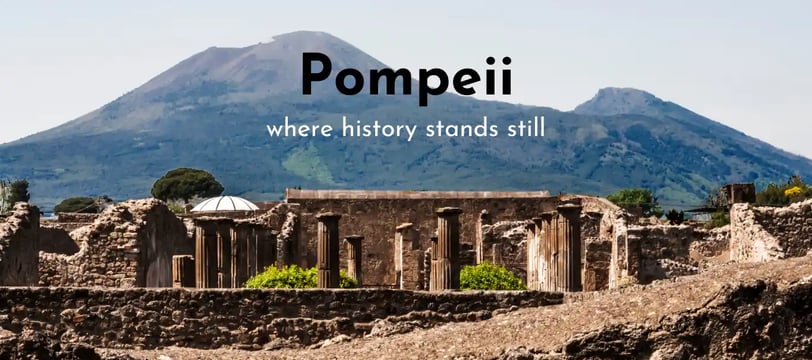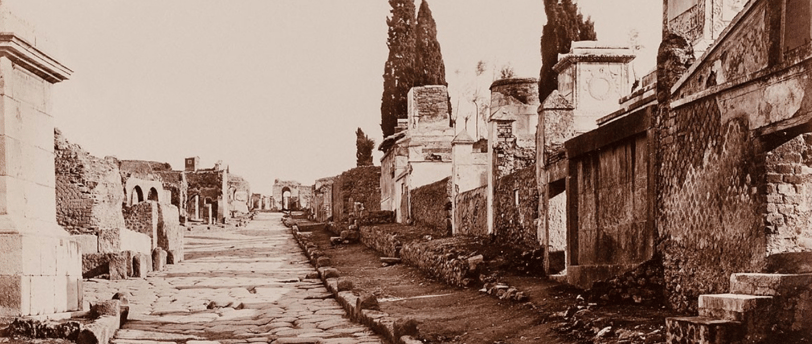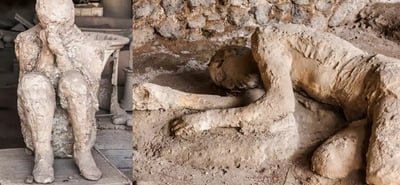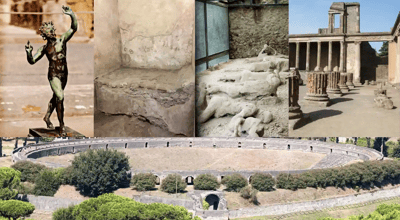A Glimpse into Pompeii: The Ancient City Preserved by Volcano
Discover the fascinating history of Pompeii in "A Glimpse into Pompeii: The Ancient City Preserved by Volcano." Explore how the catastrophic eruption of Mount Vesuvius froze daily life in this ancient Roman city, offering a rare look into its past.
HISTORICAL WONDERS
My Trip Junction
12/20/20246 min read


***Some of the links on this blog are affiliate links. This means that if you click on the link and make a purchase, I may earn a small commission at no additional cost to you. This helps support the blog and allows me to continue providing content for you. Thank you for your support!
A Glimpse into Pompeii
Nestled near the Bay of Naples, beneath the shadow of Mount Vesuvius, lies the hauntingly beautiful and utterly captivating ruins of Pompeii. Once a vibrant Roman city, Pompeii was frozen in time in AD 79 when Vesuvius erupted, burying the city under a thick layer of volcanic ash. Today, it’s one of Italy’s most visited historical sites, offering travelers a rare glimpse into the daily life of an ancient civilization. Join me as we journey through time to explore the wonders of Pompeii and uncover the stories left behind by its residents.
Chapter 1: Stepping Into History – A Glimpse of Life Before the Eruption
Imagine walking down a bustling street in ancient Rome, vendors selling fresh bread, children playing, and politicians discussing city matters in the town square. This was Pompeii—a thriving city home to about 11,000 people, brimming with life, culture, and commerce. Pompeii wasn’t just any city; it was an affluent port town that played a vital role in trade, importing exotic goods from the corners of the Mediterranean.
Archaeologists have unearthed remarkably well-preserved homes, shops, public baths, and temples in Pompeii. As you stroll through the ancient streets, it’s easy to visualize the vibrancy of the city before it was engulfed by the eruption. Marvel at the intricate frescoes that adorned the walls of villas, depicting myths, gods, and daily life in stunning detail.
Chapter 2: The Day That Changed Everything – The Eruption of Mount Vesuvius
On that fateful day in AD 79, Mount Vesuvius unleashed its fury, spewing ash, pumice, and deadly gases into the sky. The citizens of Pompeii had no warning. The thick cloud of ash covered the city so quickly that many people were trapped and suffocated before they could flee. The eruption lasted over two days, burying Pompeii under nearly 20 feet of ash.
The remarkable preservation of the city was a direct result of the eruption. Buildings, artifacts, and even the citizens themselves were frozen in time. Plaster casts of the victims, created by filling the voids left by decomposed bodies, offer a sobering reminder of the tragedy that occurred. These casts show Pompeii’s residents in their final moments, some shielding their faces, others clutching loved ones.
Chapter 3: Exploring Pompeii Today – What to See
Visiting Pompeii today is like stepping into a time machine. Here are some must-see highlights of the ancient city:
1. The Forum
Once the heart of public life in Pompeii, the Forum was where citizens gathered for political, religious, and social activities. It’s an impressive space surrounded by columns and overlooked by the towering Mount Vesuvius.
2. The Amphitheater
Dating back to 80 BC, Pompeii’s amphitheater is the oldest surviving Roman amphitheater in existence. It could hold up to 20,000 spectators, who would gather to watch gladiator matches and other public spectacles.
3. The House of the Faun
One of the largest and most luxurious homes in Pompeii, the House of the Faun showcases the opulence of Pompeian society. It’s famous for its elaborate mosaics, including the Alexander Mosaic, which depicts the battle between Alexander the Great and King Darius of Persia.
4. The Lupanar
Pompeii’s most famous brothel, the Lupanar, offers a glimpse into the city’s more controversial side. Erotic frescoes line the walls, showing scenes from Pompeii’s nightlife.
5. The Garden of the Fugitives
This poignant site contains the plaster casts of 13 victims who were attempting to flee the city when they were overtaken by the ash cloud. The casts lie in the exact positions the people were found, providing a harrowing reminder of the eruption’s human cost.
Chapter 4: How to Get to Pompeii – Your Travel Guide
Getting to Pompeii is simple, making it a must-visit destination for any traveler exploring southern Italy.
📍 Fly to Naples
The nearest airport is Naples International Airport (NAP), just 30 kilometers away from Pompeii. From Naples, you can take a train, bus, or rent a car to reach the site.
🚆 By Train
The Circumvesuviana train line connects Naples with Pompeii. The journey takes about 30-40 minutes, and you’ll want to disembark at the "Pompei Scavi – Villa dei Misteri" station, which is just steps away from the main entrance.
🚌 By Bus
Several bus companies offer direct routes from Naples to Pompeii, with travel times averaging around 45 minutes to an hour.
🚗 By Car
If you prefer driving, renting a car from Naples is a convenient option. It takes about 30 minutes to reach Pompeii, and parking is available near the archaeological site.
Explore more travel tips and guides for Pompeii and other must-see destinations on MyTripJunction.com, your go-to travel companion for unique adventures worldwide.
Chapter 5: The Cultural Legacy of Pompeii – Why It Matters
Pompeii is more than just a tourist attraction; it’s a window into a bygone world. Its preservation offers historians and archaeologists invaluable insights into Roman life. Everything from the food they ate to their political systems has been meticulously studied, making Pompeii a living classroom for the ancient world.
The cultural significance of Pompeii extends far beyond its historical value. It serves as a powerful reminder of the fragility of life, illustrating how a thriving city can be reduced to ruins in an instant. Pompeii’s story is not just one of tragedy but also resilience, as the site has transformed into one of the most visited archaeological parks in the world.
Conclusion: Why You Should Visit Pompeii
Visiting Pompeii is an experience unlike any other. The combination of stunning architecture, haunting remnants of the past, and the breathtaking backdrop of Mount Vesuvius makes this a must-see destination for history lovers and casual travelers alike. Whether you’re wandering through ancient streets or standing in awe of the plaster casts, you can’t help but feel connected to the lives that once filled this city.
So, pack your bags and add Pompeii to your bucket list. Whether you’re visiting Italy for the first time or returning for another adventure, Pompeii is a destination that will leave you spellbound.
Book your tickets now with MyTripJunction.com. Your next unforgettable journey awaits!
Frequently Asked Questions about Pompeii
1. How long does it take to tour Pompeii?
Most visitors spend around 4-5 hours exploring Pompeii, but if you’re really interested in archaeology and history, you could easily spend a full day. There’s so much to see, including ancient streets, homes, amphitheaters, and preserved frescoes.
2. What should I wear when visiting Pompeii?
Pompeii can get quite hot, especially in the summer, so it’s a good idea to wear light, breathable clothing. Comfortable walking shoes are a must as the site is large, and the ancient streets are uneven. Don’t forget a hat and sunscreen to protect yourself from the sun.
3. Is Pompeii accessible for people with disabilities?
While the ancient ruins are not fully accessible, there is an accessible route called the “Pompeii for All” itinerary, designed to make the visit easier for those with mobility issues. This path covers many of the site’s most important areas.
4. Can I visit Pompeii on my own or should I take a guided tour?
You can absolutely visit Pompeii on your own, but a guided tour can really enhance your experience. Guides provide in-depth knowledge of the history and stories of the city, helping to bring the ruins to life.
5. What are the opening hours for Pompeii?
Pompeii is open year-round, typically from 9:00 AM to 7:30 PM, with the last entrance around 6:00 PM. However, hours can vary depending on the season, so it’s a good idea to check ahead of time, especially on holidays.
6. How do I get to Pompeii from Naples?
Pompeii is just a short 30-minute train ride from Naples. You can take the Circumvesuviana train from Naples Central Station (Napoli Centrale) to the Pompei Scavi-Villa dei Misteri stop, which is close to the entrance of the ruins.
7. Are there facilities like restaurants or restrooms at Pompeii?
Yes, there are restrooms and a cafeteria at Pompeii, but it’s recommended to bring water and snacks with you, especially if you plan to spend several hours exploring.
8. Is Pompeii worth visiting with kids?
Yes, Pompeii is fascinating for visitors of all ages. While younger children may not fully grasp the historical significance, the ancient streets and preserved buildings can capture their imagination. Be sure to bring water, as it can get hot, and plan for plenty of rest breaks.






Explore
Your ultimate travel planning experience awaits you.
Connect
Support
info@mytripjunction.com
© 2024. All rights reserved.
